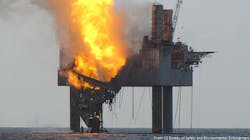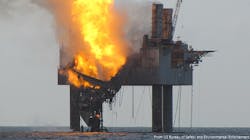A natural gas well blew out and caught fire in late July 2013 in the Gulf of Mexico because crews incorrectly calculated the drilling fluid’s density and failed to account for the full range of temperatures that could be encountered, the US Bureau of Safety and Environmental Enforcement said in a Sept. 10 report.
Walter Oil & Gas Corp. was completing a well on South Timbalier Block 220 using a Hercules Offshore Inc. jack up rig at 8:40 a.m. on July 23, 2013, when a kick escalated into a blowout (OGJ Online, July 26, 2013). High-pressure gas flowed through the blowout preventer (BOP), which was unable to contain the influx, and 44 people, some with minor injuries, were evacuated about 2 hr later.
The gas ignited and burned for 2 more days before natural accumulation of sediment inside the well stopped the fire by cutting off its fuel, the US Department of the Interior agency’s report said. “A relief well was ultimately drilled to relieve pressure and gain control of the well,” it noted.
Typically, a formation into which a well is drilled exerts pressure on it, the report said. Circulation of completion fluid into the well is meant to maintain a pressure balance and control the flow of hydrocarbons into the well, it said.
The panel that prepared the report concluded that the South Timbalier A-3 well’s crew encountered higher-than-expect temperatures, which affected the completion fluid’s density. “As a result, the completion fluid did not effectively maintain the pressure balance in the well, which resulted in the flow of hydrocarbons into the well,” it said.
“Rig-floor personnel failed to recognize signs of this kick in its early stages,” the report said. “Crew on the rig floor only became aware that the kick occurred when completion fluid began to shoot out from the open end of the annulus and drill pipe. With the zinc bromide fluid raining down on them, the crew began to have difficulty working as the fluid caused a burning sensation to their eyes and skin. This exposure accounted for the minor injuries reported by the crew.”
Tardy kick detection
Failure to detect the kick before it reached the surface also kept the crew from following well-control procedures in time, the report said. A final attempt to regain control by closing the rams, including the BOP’s blind shear rams, also came too late, it indicated.
“There are similarities between this incident and others that have occurred on the Outer Continental Shelf,” BSEE Director Brian M. Salerno said in a Sept. 10 memorandum to Gulf of Mexico Region Director Lars M. Herbst and Office of Offshore Regulatory Programs Chief Doug Morris.
“Thankfully, the entire crew of 44 workers was able to evacuate the rig,” Salerno said. “However, given these equipment and human failures noted in the report, this incident could have resulted in a more tragic outcome, and must be viewed as very serious. In all such cases, we must fully understand the root causes so we can work to prevent recurrence.”
BSEE needs to do more work on BOP component failures, accumulator hydraulic control pressure, safety valve closure, flow detection equipment, and human factors, Salerno said. He told the BSEE officials to complete work on immediate concerns within 45 days and more complex problems in 6 months.
“The blowout at South Timbalier 220 offers several lessons for offshore operators, the most important being that there is no safe time to become complacent about maintaining proper control of a well,” Morris said in a Sept. 10 blog. A full job safety analysis under the operator’s Safety and Environmental Management System (SEMS) plan should be the first order of the day every time an activity identified in the SEMS plan takes place, he suggested.
“It also demonstrates why critical safety equipment, such as the [BOP], must be fully functional when called upon to stop a loss of well control,” Morris said. “Finally, it shows why operators must have control of a well’s fluid volume and hydrostatic pressure before engaging in tripping activities. Tripping out in an unbalanced pressure situation adds too many additional variables that can quickly result in an emergency situation with human and environmental impacts.”
A Hercules Offshore spokesman said on Sept. 11 that the offshore drilling contractor did not have an immediate comment on the report. Walter Oil & Gas did not respond to OGJ’s request for a statement.
Contact Nick Snow at [email protected].
About the Author

Nick Snow
NICK SNOW covered oil and gas in Washington for more than 30 years. He worked in several capacities for The Oil Daily and was founding editor of Petroleum Finance Week before joining OGJ as its Washington correspondent in September 2005 and becoming its full-time Washington editor in October 2007. He retired from OGJ in January 2020.

